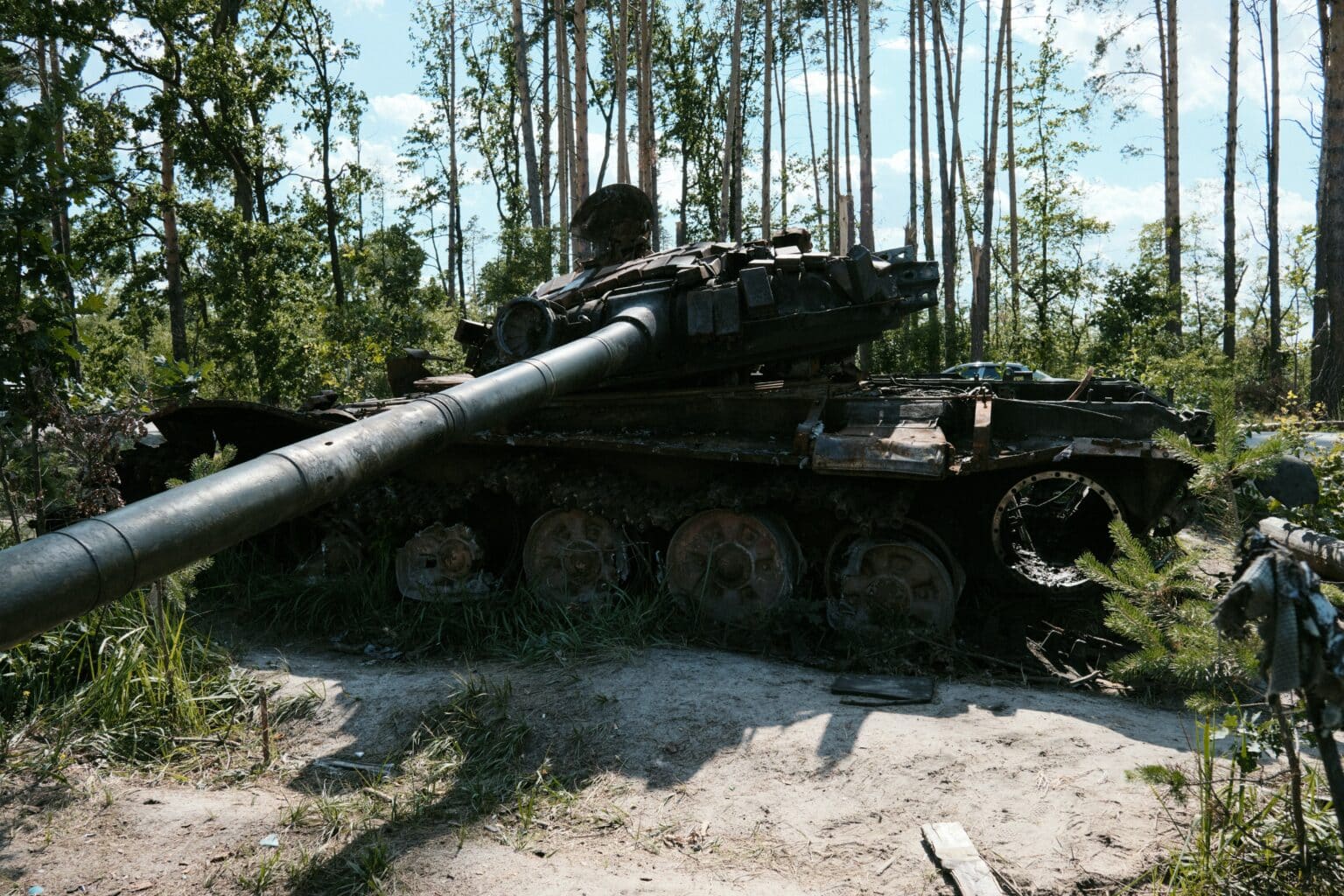February 24 marked one year since Russia invaded Ukraine. What was initially expected to be a quick annexation by a superior military power has turned out to be anything but. Military experts even tell Political IQ, Ukraine could potentially achieve victory within months.
“No Path To Victory” For Russia
“Russia has lost this war—but they’re not beaten yet,” says Rebecca Grant, National Security Analyst with IRIS Independent Research. “There is no path to victory for Putin, and that’s been true for a while.”
The war has “galvanized NATO,” she notes, which is currently training Ukrainian forces in the UK.
“Whatever kind of professional army [the Russians] had, it’s gone,” adds Gian Gentile, Senior Historian at the Rand Corp. He points out that the Russians thought they were going to “snatch up” Kyiv pretty quickly but had to shift that tactic early in the war. “And now you’re just doing the old Russian thing”—which is “trying to conquer with artillery fire power and occupy with infantry.”
“It worked in World War II because they had millions and millions and millions of soldiers,” says Gentile. “Now they don’t have that.”
He goes on to explain that they’re trying to create mass through “overwhelming dismounted power.” But in order to break the Ukrainian lines, the Russians need to not just throw “waves and waves” of infantry at the enemy, they need to combine armor—and he’s “skeptical” that Russia has the ability to do this.
Western Weapons Have Been Game Changers For Ukraine
“Russia as a tool of war is very capable of simply massing troops and throwing them at the forces of the Ukrainians,” retired Adm. James Stavridis, former NATO Supreme Allied Commander, said earlier this month. “So what do we do about it from the military capability? We bring technology to bear.”
The tanks recently promised—and in some cases already given—to Ukraine by the U.S., Germany and other Western nations, have been touted as potential “game changers,” but they’re not the only weapons that have made a difference in the past year.
Both Grant and Gentile point to the HIMARS—the High Mobility Artillery Rocket System—as having been among the most impactful for Ukraine. The U.S. has donated at least 20 to the cause so far.
“That caused the Russians to definitely shift their tactics and their operational approach,” says Gentile of the HIMARS. “They had to move supply points back which created big problems for them because so much of their supply, it needed to be moved by rail because they still don’t have enough trucks.”
Grant also points to a “weapon” far less talked about: the sharing of intelligence and surveillance and reconnaissance. “Whether it’s in cyberspace or through commercial space imagery, there’s been a sharing of intelligence from NATO to Ukraine that has helped Ukraine use its smaller, outnumbered forces very effectively. That has been a game changer, certainly,” she says.
What she says has not been a game changer for the Russians are the Iranian-supplied drones. “They’re not getting Putin any closer to victory,” she states—although she admits to being “shocked at the level of destruction they have been able to cause.”
U.S. And NATO In For The Long Haul
The announcement in late January that the Biden Administration would be sending Ukraine some 31 M1 Abrams tanks was accompanied by the news that the tanks would not likely be field ready for up to a full year—suggesting that the West is expecting a drawn-out conflict.
“Well, remember that the U.S. and NATO are in for the long haul because they will continue to provide security assistance for Ukraine even after the war stops,” says Grant. “So, some of this is about reconfiguring Ukraine’s long-term defense posture.”
Back in July, Professor Michael Clarke, former Director of the Royal United Services Institute in Australia, surmised, “I think this may turn into a 20-year war that flares up for 18 months at a time, three or four times over a 20-year period,” adding, “This war lasts as long as Putin lasts and probably some time into his successor.”
“That’s what’s got to be avoided,” cautions Grant. “And I think the way to avoid that is to drive Russia out of more of the territory that they have taken in Ukraine, and to include Crimea if they can do it. And there’s no tactical reason why Ukraine can’t ultimately take Crimea.”
Gentile, a veteran of the Iraq War, doesn’t buy the 20-year slog theory. “At a certain point both sides have got to say, ‘We just can’t,’” he says.
Putin Had Eased Up On The Nuclear Threat—Until This Week
As late as the fall, we heard concerns from national security analysts like John Bolton that Putin might deploy a tactical nuclear weapon—particularly after Russia’s trouncing at Karkhiv. Such rhetoric had faded in the past several months.
Until this week. U.S. officials said Russia carried out a test of an intercontinental ballistic missile on Monday, but the test appears to have failed.
And during his annual State of the Nation address on Tuesday, Putin announced that he was suspending participation in the 2010 New START treaty following Biden’s surprised visit to Ukraine. Only hours later, though, Russia’s Foreign Ministry on Tuesday said it would respect the nuclear weapons caps proposed under that treaty, and that Russia would continue to exchange information about ballistic missile test launches, as per earlier agreements with the U.S.
Further, Putin’s rhetoric has remained more cryptic than direct. “As before, we will pay increased attention to strengthening the nuclear triad,” he said in a speech during the run-up to February 24, referring to nuclear missiles based on land, sea and in the air.
Grant says that Chinese President Xi Jinping told Putin to ease off. “And because China’s support is absolutely vital to Russia, the rhetoric dried up right then. That was in early November,” she says. “Also, Putin knows he cannot risk the use of nuclear weapons that at a minimum blows back on Russian territory. And the risk of legitimate NATO retaliation is far too high.”
She also believes the nuclear threat had been Putin’s attempt to scare the West into not giving Ukraine aid. And it clearly didn’t work. According to one estimate, the U.S., the UK and the EU provided Ukraine more than $123 billion between January 2022 and 2023.
Just this past week, during his visit to Kyiv, Biden announced an additional half-billion dollars in U.S. assistance, including shells for howitzers, anti-tank missiles, air surveillance radars and other aid but no new advanced weaponry. And on Friday, the war’s one-year mark, the U.S. committed yet another $2 billion in ammunition, drones and aid to Ukraine. This week’s additional aid comes on top of the roughly $45 billion that was approved within the bipartisan $1.7 trillion omnibus spending package that Congress passed in December.
Will Congress Pull Back On Aid?
But speaking of Western aid, Rep. Matt Gaetz (R-FL) earlier this month led a group of 11 Republican lawmakers in introducing a bill called the Ukraine Fatigue Resolution to try to cut off funding for the war.
The bill comes after now-Speaker Kevin McCarthy (R-CA) last year warned that there would be no “blank check” for Ukraine once the Republicans took majority of the House on January 3. “We want to make sure there’s accountability for everybody, the money that is spent,” McCarthy has said.
“The majority of Congress understands that this is crucial,” countered Rep. Mike Turner (R-OH), Chair of the House Intelligence Committee, referring to U.S. aid to Ukraine on February 12. “We are fighting on the front lines of democracy.”
“We have to educate, where has the money gone,” added Rep. Michael McCaul (R-TX), Chairman of the House Foreign Affairs Committee. “I still believe there are many on both sides of the aisle, a majority of the majorities, in support of this.”
“In late January, the Pentagon and State Department came out with the first inspection report on Ukraine,” says Grant. “It’s really detailed, and that along with anything else Congress wants, I think will help.”
Next Six Months Could Be Crucial
“I think something is going to happen in the next six months,” says Gentile. He’s remarking on claims by Ukrainian Defense Minister Oleksii Reznikov that Russia has amassed some 500,000 troops on Ukraine’s eastern border.
“I haven’t seen 500,000. I thought I saw 300,000,” says Gentile. “But whatever the number is, clearly what they are trying to do is create mass through overwhelming dismounted power.”
It’s part of an expected major Russian offensive that was predicted to kick off exactly one year after Russia’s invasion, February 24. However, it may have already begun earlier this month.
“How successful the Russians are, I don’t think they’re going to be, but who knows?” adds Gentile. “But then the counter to this is what the Ukrainians do. That’s why I’m saying it feels like both sides are getting ready to try and do something big. That’s why I think something’s going to happen in the next six months.”
Further, says Grant, “When I look at that map, I see that Ukraine has the potential to split the Russian front and bring the war to a conclusion that way within this calendar year. I think they have that potential, given their battlefield position today.”
While Intel Chairman Turner said this: “The fact that Zelensky has been a president that will rally his country to fight against Russia, we’ve been able to arm them, is really unprecedented that a nation like that could stand up to a superpower like Russia, but they are doing so with the commitment to keep the sovereignty of their nation.”


